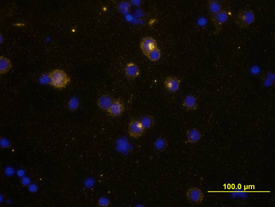Human IL-2 Antibody Summary
Ala21-Thr153
Accession # P60568
Applications
This antibody functions as an ELISA detection antibody when paired with Mouse Anti-Human IL‑2 Monoclonal Antibody (Catalog # MAB2021).
This product is intended for assay development on various assay platforms requiring antibody pairs. We recommend the Human IL-2 DuoSet ELISA Kit (Catalog # DY202) for convenient development of a sandwich ELISA or the Human IL-2 Quantikine ELISA Kit (Catalog # D2050) for a complete optimized ELISA.
Please Note: Optimal dilutions should be determined by each laboratory for each application. General Protocols are available in the Technical Information section on our website.
Scientific Data
 View Larger
View Larger
Detection of Human IL‑2 by Western Blot. Western blot shows lysates of monensin treated human peripheral blood mononuclear cells (PBMCs) with no additional treatment (-) or additionally treated (+) with 0.5 μg/mL calcium ionomycin (Iono) and 50 ng/mL PMA overnight. PVDF membrane was probed with 0.5 µg/mL of Goat Anti-Human IL-2 Antigen Affinity-purified Polyclonal Antibody (Catalog # AF-202-NA) followed by HRP-conjugated Anti-Goat IgG Secondary Antibody (HAF017). A specific band was detected for IL-2 at approximately 14 kDa (as indicated). This experiment was conducted under reducing conditions and using Immunoblot Buffer Group 1.
 View Larger
View Larger
IL‑2 in Human PBMCs. IL-2 was detected in immersion fixed human peripheral blood mononuclear cells (PBMCs) stimulated with PMA, ionomyocin, and monensin using Goat Anti-Human IL-2 Antigen Affinity-purified Polyclonal Antibody (Catalog # AF-202-NA) at 10 µg/mL for 3 hours at room temperature. Cells were stained using the NorthernLights™ 557-conjugated Anti-Goat IgG Secondary Antibody (yellow; (NL001) and counter-stained with DAPI (blue). View our protocol for Fluorescent ICC Staining of Non-adherent Cells.
 View Larger
View Larger
Cell Proliferation Induced by IL‑2 and Neutralization by Human IL‑2 Antibody. Recombinant Human IL-2 (202-IL) stimulates proliferation in the CTLL-2 mouse cytotoxic T cell line in a dose-dependent manner (orange line) as measured by Resazurin (AR002). Proliferation elicited by Recombinant Human IL-2 (2 ng/mL) is neutralized (green line) by increasing concentrations of Goat Anti-Human IL-2 Antigen Affinity-purified Polyclonal Antibody (Catalog # AF-202-NA). The ND50 is typically ≤ 0.15 µg/mL.
Reconstitution Calculator
Preparation and Storage
- 12 months from date of receipt, -20 to -70 °C as supplied.
- 1 month, 2 to 8 °C under sterile conditions after reconstitution.
- 6 months, -20 to -70 °C under sterile conditions after reconstitution.
Background: IL-2
Interleukin-2 (IL-2) is a O-glycosylated, four alpha -helix bundle cytokine that has potent stimulatory activity for antigen-activated T cells. It is expressed by CD4+ and CD8+ T cells, gamma δ T cells, B cells, dendritic cells, and eosinophils (1 - 3). Mature human IL-2 shares 56% and 66% aa sequence identity with mouse and rat IL-2, respectively. Human and mouse IL-2 exhibit cross-species activity (4). The receptor for IL-2 consists of three subunits that are present on the cell surface in varying preformed complexes (5 - 7). The 55 kDa IL-2 R alpha is specific for IL-2 and binds with low affinity. The 75 kDa IL-2 R beta, which is also a component of the IL-15 receptor, binds IL-2 with intermediate affinity. The 64 kDa common gamma chain gamma c/IL-2 R gamma, which is shared with the receptors for IL-4, -7, -9, -15, and -21, does not independently interact with IL-2. Upon ligand binding, signal transduction is performed by both IL-2 R beta and gamma c. IL-2 is best known for its autocrine and paracrine activity on T cells. It drives resting T cells to proliferate and induces IL-2 and IL-2 R alpha synthesis (1, 2). It contributes to T cell homeostasis by promoting the Fas-induced death of naïve CD4+ T cells but not activated CD4+ memory lymphocytes (8). IL-2 plays a central role in the expansion and maintenance of regulatory T cells, although it inhibits the development of Th17 polarized cells (9 - 11). Thus, IL-2 may be a key cytokine in the natural suppression of autoimmunity (12, 13).
- Ma, A. et al. (2006) Annu. Rev. Immunol. 24:657.
- Gaffen, S.L. and K.D. Liu (2004) Cytokine 28:109.
- Taniguchi, T. et al. (1983) Nature 302:305.
- Mosmann, T.R. et al. (1987) J. Immunol. 138:1813.
- Liparoto, S.F. et al. (2002) Biochemistry 41:2543.
- Wang, X. et al. (2005) Science 310:1159.
- Bodnar, A. et al. (2008) Immunol. Lett. 116:117.
- Jaleco, S. et al. (2003) J. Immunol. 171:61.
- Malek, T.R. (2003) J. Leukoc. Biol. 74:961.
- Laurence, A. et al. (2007) Immunity 26:371.
- Kryczek, I. et al. (2007) J. Immunol. 178:6730.
- Afzali, B. et al. (2007) Clin. Exp. Immunol. 148:32.
- Fehervari, Z. et al. (2006) Trends Immunol. 27:109.
Product Datasheets
Citation for Human IL-2 Antibody
R&D Systems personnel manually curate a database that contains references using R&D Systems products. The data collected includes not only links to publications in PubMed, but also provides information about sample types, species, and experimental conditions.
1 Citation: Showing 1 - 1
-
Natural and induced CD4+CD25+ cells educate CD4+CD25- cells to develop suppressive activity: the role of IL-2, TGF-beta, and IL-10.
Authors: Zheng SG, Wang JH, Gray JD, Soucier H, Horwitz DA
J. Immunol., 2004-05-01;172(9):5213-21.
Species: Human
Sample Types: Whole Cells
Applications: Neutralization
FAQs
No product specific FAQs exist for this product, however you may
View all Antibody FAQsReviews for Human IL-2 Antibody
Average Rating: 5 (Based on 2 Reviews)
Have you used Human IL-2 Antibody?
Submit a review and receive an Amazon gift card.
$25/€18/£15/$25CAN/¥75 Yuan/¥2500 Yen for a review with an image
$10/€7/£6/$10 CAD/¥70 Yuan/¥1110 Yen for a review without an image
Filter by:
Used for detection of IL2 conjugated to the target-specific antibody. Used either as a capture or a detection antibody after labeling with biotin or sulfo-tag, respectively, according to the manufacturer’s protocol (Meso Scale Diagnostics LLC).
Detection range of IL-2 conjugates was 10-225,000 pg/ml for anti-IL2-Biotin/anti-Fc gamma-Sulfo-Tag (A) and 50-225,000 pg/ml for anti-Fc gamma-Biotin/anti-IL2-Sulfo-Tag capture/detection combination (B).












